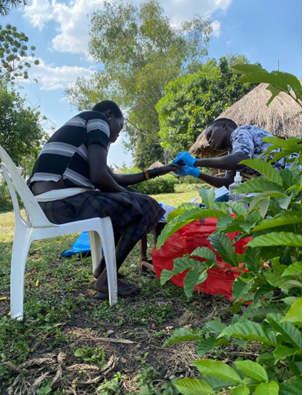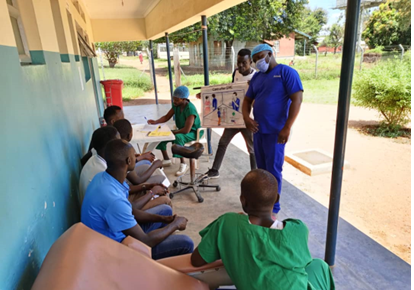- Plot 724/5, Mawanda Road, P.O Box 7484, Kampala Uganda
- +256 393 516266
- mail@anecca.org

Category Page: USAID LPHS-KARAMOJA
Community APN testing in Iriri Napak district

The Activity supported 67 public health facilities to offer targeted HIV testing services using nationally approved strategies such as APN, Index testing, SNS and PITC among others. During the quarter, a total of 29,124 individuals were tested for HIV leading to a cumulative achievement of 36% (81,087) of the annual target. Overall, 132 (16.1% of annual target of 822) individuals tested HIV-positive in FY24 QTR1, leading to an overall positivity of 0.45% (132/29,124) (Table 13) and 100% linkage to care and treatment. During the quarter, LPHS-Karamoja supported the implementation of proven HTS modalities ranging both at facility and community to ensure appropriate case identification and linkage to care. During the quarter, emphasis was placed on Health workers screening of all OPD clients for HTS eligibility using the National HTS screening tool and the testing of all eligible clients thereof. Recency data was also used to identify hotspot areas for targeted community outreach. The activities also focused on optimizing yield among men, adolescents (AGYW & ABYM), children, pregnant and breastfeeding women, and other priority population categories e.g. gold (Rupa) and marble miners (Kosiroi) in Moroto district at risk of HIV infection. Furthermore, to address the unmet demand for HIV testing among adolescents, young women, and boys (AGYWB), and men above 30years especially partners of pregnant women and nursing mothers., Despite the low HTS yield, 100% (N=132) of the HIV positive clients identified in FY24 QTR1 were all linked to care except one client in Nakapiripirit who was still in denial and is still undergoing counselling. During FY24 QTR2, LPHS Karamoja will continue supporting the scale up of the national HTS Quality improvement collaborative in all the 67 supported health facilities to improve the quality of HTS screening, testing and the yield. The activity will continue utilizing recency data to map areas with new infections for targeted and intensified scale up of high yielding modalities like index testing, APN, and SNS among others.
VMMC Health Education at Kaabong Hospital

During FY24 QTR1, LPHS-Karamoja supported the 8 MOH accredited VMMC sites1 with targets to offer VMMC services. Further, the activity supported the Kotido and Kaabong Hospitals VMMC teams to train in the Shang Ring device method to provide the service to eligible clients. A total of 3,319 males were circumcised in FY24 QTR1, equivalent to 33% of the annual target (10,123) or 131% of the quarterly target (2,531). Of these, 11 were undertaken using the shangring method representing an achievement of 7% (11/152) of the quarterly target (table 11). Overall, the good achievement in VMMC is attributed to improved mobilization in institutions of learning, targeted outreaches to the mapped communities with high unmet need and improved post-operative care that creates client satisfaction. However, suboptimal performance in Kaabong and Karenga was attributed to but not limited to misconceptions and cancellation of outreaches due to competing activities in the districts. The activity will continue to provide targeted support to the districts with low performance, particularly targeting Shangring method uptake in Kotido and Kaabong Hospitals to scale up performance in the forthcoming quarter to enable them to achieve the bi-annual target. During FY24 QTR2, the activity will focus on targeting the 30+ men with quality demand creation approaches for VMMC. The Activity will also scale up mentorships to all 8 target sites and support establishment of VMMC surgical outpatient day for prioritizing walk-in clients
PMTCT Performance review targeting ADHO MCH and PMTCT focal persons of each facility

LPHS-Karamoja in dynamic collaboration with USAID UHA, Moroto Regional Referral Hospital G2G and district-based mentors, demonstrated unwavering commitment by delivering robust technical assistance and mentorship to elevate the operational capabilities of the 53 target ART health facilities across the nine districts. This collaborative initiative strategically harnessed the national Accelerating Progress in PMTCT and Pediatrics (AP3) framework, embodying a holistic and synergistic approach. The activities implemented in the quarter included, Regional PMTCT performance review meeting with 9 District PMTCT FPs and 1 ADHO-MCH, District based PMTCT performance review meeting across the 9 districts where 52 midwives, 40 health information assistants, 2 laboratory technicians, 4 Biostatisticians, 5 district HMIS Focal persons, 1 CAO, 2 DHOs, 6 ADHOs-MCH, and 9 District PMTCT FPs were in attendance. The focus was to identify the root cause for the poor EID coverage across the region, during the meeting, we reviewed the MCH registers to rule out documentation gaps, reviewed the HMIS105 reports, validated the data reported in the different systems and built the capacity of the teams in different indicator definitions. The collaborative approach employed by LPHS-Karamoja, in conjunction with USAID UHA and district-based mentors, underscored the commitment to achieving accelerated progress in PMTCT and pediatrics (AP3). By harmonizing strategies and leveraging on the collaborative framework, this initiative aimed not only to enhance the quality of healthcare services but also to contribute significantly to the overarching goal of preventing mother-to-child transmission of HIV and promoting comprehensive health outcomes for both mothers and children in the Karamoja region.

